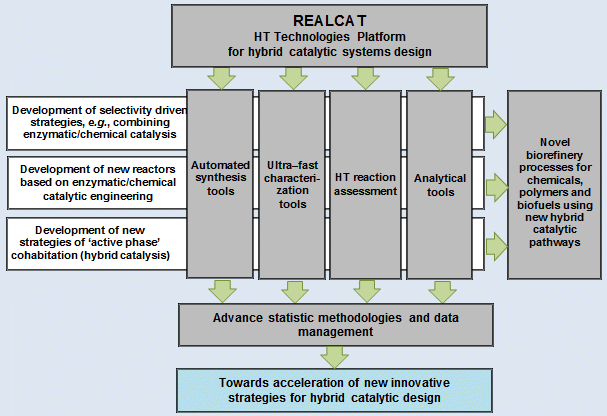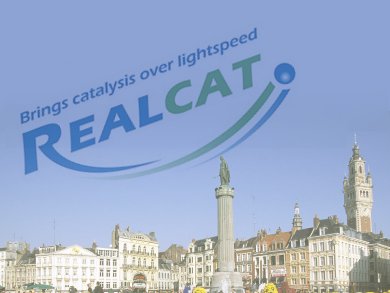Innovation in Catalysis
Catalysis was underlined as a Key Technology by the French Ministry of Economy, Finances and Industry in 2010 [1]. This is not surprising as it is at the origin of more than 80 % of the added value of the chemical industry [2]. Moreover, catalysis in all of its forms, namely heterogeneous, homogeneous, or biocatalysis, is of upmost interest in many crucial domains such as Environment, Food, Health, Energy, which are at the inner core of the current societal demands. The development of new catalysts with improved performances is, therefore, a highly strategic issue.
Innovation in catalysis is based, on the one hand, on forefront fundamental research to develop new catalytic concepts and, on the other hand, on an experimental phase devoted to the synthesis, characterization of the catalytic formulations, and on the measurement of their properties/performances. The experimental part of the development of a new catalyst is time- and money-consuming, as traditional “trial and error” methods for synthesizing and testing catalysts are still needed. “A priori” theoretical prediction of optimal catalyst composition, structure, and conditions of preparation for a given reaction is not yet possible. Therefore, there is a strong need for rapid preparation, characterization, and screening of catalytic systems.
Aims
The main objective of the REALCAT project (French acronym standing for ‘Advanced High-Throughput Technologies Platform for Biorefineries Catalysts Design’) is to set up a highly integrated platform devoted to the acceleration of innovation in all the fields of industrial catalysis with an emphasis on emergent biorefinery catalytic processes.
In this extremely competitive field, REALCAT consists of a versatile High-Throughput Technologies (HTT) platform devoted to innovation in heterogeneous, homogeneous, or bio- catalysts AND their combinations under the ultra-efficient very novel concept of hybrid catalysis, also specifically developed in this project (Fig. 1). Indeed, the combination of HT experiments that enable (1) generating large quantities of data in a short period of time with (2) statistical experimental design procedures in order to obtain the desired information with a minimum number of experiments, is an outstandingly efficient approach [3, 4].

Figure 1. REALCAT conceptual scheme.
The REALCAT platform, which will be fully operational early 2014, implements this methodology in a complete, unique, and top-level HTT workflow including (1) robots for the automated synthesis of catalysts and novel biocatalysts, (2) rapid characterization tools, and (3) a series of versatile parallel continuous and batch reactors – for gas phase, liquid phase or three phases reactions – combined with ultra-fast analytical tools at the top of the state-of-the-art for the analysis of the products in the reactor effluents.
After completion, such a complete and versatile HT platform devoted to catalysis under all of its forms (enzymatic, heterogeneous, and homogeneous) as well as their combinations (hybrid catalysis), and including preparation, characterization, and testing at the same place will be unique in the world.

Latest Equipment
This project received 8.7 million Euros of funding from the French Government, managed by the National Research Agency (ANR) within the program of Investments for the Future (PIA) attributed end 2011.
REALCAT will be open to external users, either academics and/or industrials in the frame of research collaborations and/or provisions of services, with respective staggered access fees under a secured and confidential environment. The platform will be highly versatile, and, in addition to catalysts for biorefineries, projects for many different kinds of homogeneous, heterogeneous, and biotechnological catalytic applications in gas, liquid or gas-liquid phases, involving a large variety of reactions (synthesis, functionalization, polymerization, etc.) for a wide spectrum of applications (solvents, monomers, polymers, fine chemicals for industrial, food, feed, pharmaceutical, cosmetics, fuels, etc.) can be done. Even projects dedicated to the synthesis of materials, namely organic, inorganic or hybrid solids (e.g., MOFs) for non-catalytic applications can be carried out on REALCAT.
Significant scientific, technical, and economic beneficial effects are expected from this equipment, which will gather the top-level up-to-date components available on the market. Moreover, within the frame of the REALCAT project, methodological developments will also be carried out in partnership with private companies in order to develop innovative HTT tools for catalysis not yet available on the market. This will ensure that the REALCAT platform remains the most advanced level of HT equipment for catalysis in the world in the future.
Expertise from Four Labs
Four laboratories, all located on Lille 1 University’s campus in the North of France have gathered their forces to design such a challenging project. Professor Franck Dumeignil and Professor Sébastien Paul from UCCS – Unité de Catalyse et de Chimie du Solide (UMR CNRS 8181) – are respectively the coordinator and head scientist of the REALCAT project. UCCS is already involved in many research contracts with academic and industrial partners. UCCS has notably been entrusted by the EC as coordinator of the very large-scale EuroBioRef European project (EUROpean Multilevel Integrated BIOREFinery Design for Sustainable Biomass Processing; FP7 2010-2014). It gathers 30 partners from 15 countries, including 13 industrial ones. UCSS is also, for example, coordinating the WP3 ‘Catalysis and Biocatalysis for Oleochemistry’ of the GENESYS program ‘Genesys of Lipids Biorefinery’, part of the ANR IEED PIVERT (Picardy, Innovation, Valorization, Education and Technological Research).
The ProBioGEM lab is also already largely recognized for its strong expertise in the fields of bio-catalysis. ProBioGEM is coordinator of PHYTOBIO, an INTERREG IV project with eight partners for the discovery of novel biopesticides, partner of MESIAB, an ERA-IB project (7 partners) dedicated to the characterization of the enzymatic pathway leading to a natural anticancer drug, partner of AMBER (11 partners), an ITN project dedicated to the fundamental knowledge of Bacillus subtilis metabolism and physiology and partner of the ANR BSurf dedicated to the control of the biosynthesis of a new lipopeptide.
Moreover, a strong partnership has been set with the LAGIS (Laboratoire d’Automatique, Génie Informatique et Signal), which is a laboratory specialized in computer engineering and data treatment at Lille 1 University. LAGIS is entrusted with the development of new algorithms for data analysis for inference and clustering based on the use of a non-parametric Bayesian method, of which the originality consists of self-adaptation to the complexity of the data set of the afferent dataflow without any strong hypothesis on the dimensions of the models. As a strong point, LAGIS is one of the very first laboratories that acquired the know-how for applying these methods to signal treatment and its activities are now recognized at the national and international level.
Further, the LIFL (Laboratoire d’Informatique Fondamentale de Lille’ or Computer Science Laboratory of Lille), also on the Lille site, a laboratory dealing with informatics, is backing-up the developments in this project. It uses its well-recognized expertise in bio-informatics, modeling and analysis of biologic systems, with new recent insights in synthetic biology.
Industrial Collaboration
The REALCAT consortium is also collaborating with the Dutch company Avantium playing the role of technical advisor for the selection of the top-level hardware equipment and software. Avantium is also the supplier of three Flowrence® units present on REALCAT, specially designed for the determination of the catalytic performance of heterogeneous catalysts. Further, two synthesis robots were already ordered at Chemspeed and a first set of powerful analytical tools from Shimadzu has also already been acquired.
This integrated combination of skills is of outstanding importance for the optimization of the different operations of the platform. This will make REALCAT a major actor of high-level R&D catalysis programs on hot topics such as biorefinery, energy, environmental, food, and health applications.
References
[1] www.industrie.gouv.fr/techno_cles_2010/
[2] J. Hagen, Industrial Catalysis: A Practical Approach, 2nd Ed., Wiley-VCH, Weinheim, Germany, 2006. ISBN: 978-3-527-31144-6
[3] S. Senkan, Angew. Chem. Int. Ed. 2001, 40, 312–329. 3.0.CO;2-I”>DOI: 10.1002/1521-3773(20010119)40:2<312::AID-ANIE312>3.0.CO;2-I
[4] J. M. Caruthers, J. A. Lauterbach, K. T. Thomson, V. Venkatasubramanaian, C. M. Snively, A. Bhan, S. Katare, G. Oskarsdottir, J. Catal. 2003, 216, 98–109. DOI: 10.1016/S0021-9517(02)00036-2
If you wish to know more about REALCAT or are interested in using it, feel free to contact us at [email protected] or [email protected]
Also of interest:




